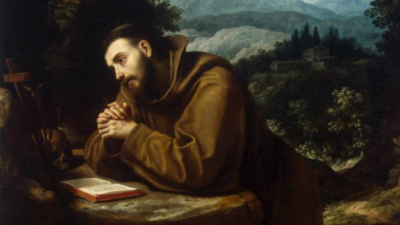Fasting
St. Francis of Assisi
Francis was noted for the practice of fasting, but that was a common medieval spiritual practice. What role did fasting play in the Franciscan spiritual life?

Of the three traditional Lenten practices: prayer, almsgiving, and fasting, it is the last one that is perhaps the one that is hardest to extract from the historical record. This is for two reasons. First, fasting was part and parcel of medieval Christianity. Second, Francis mentions fasting, but does not expound upon its meaning directly.
The meaning and context of medieval fasting. In the OT there were two kinds of fasts, public and private. The most notable, and only one required by the law of Moses was on the great Day of Atonement, thus fasting was a penitential practice associated with reconciliation from sin. In addition, there are biblical records of public fasts being proclaimed in times of distress, lamentation, and at the prophetic insistence for various situations. The public fasts were generally connected to communal sins and lasted a day. Private fasts were generally acts of penance.
After the fall of Jerusalem at the hands of the Babylonian empire (587 BC), as Israel reflected on its plight during the subsequent exile period, it was recognized that many people only carried a ritualistic sense of fasting and had lost an understanding of the larger covenantal relationship to God. It is in this era that the prophet Isaiah wrote: “5 Is this the manner of fasting I would choose, a day to afflict oneself? To bow one’s head like a reed, and lie upon sackcloth and ashes? Is this what you call a fast, a day acceptable to the LORD? 6 Is this not, rather, the fast that I choose: releasing those bound unjustly, untying the thongs of the yoke; Setting free the oppressed, breaking off every yoke? 7 Is it not sharing your bread with the hungry, bringing the afflicted and the homeless into your house; Clothing the naked when you see them, and not turning your back on your own flesh?” (Isaiah 58:5-6) Clearly the ideal of fasting was to help establish an intentionality about prayer and almsgiving, things commended by the Covenant.
In the gospels of the New Testament, fasting does not have the prominence given to prayer and almsgiving. While there are several passages mentioning fasting, in large part they are critics of rote pious practices that lacked true humility and repentance. In the other NT texts, we see fasting at important events such as at the conversion of Paul, the start of missionary endeavors, and the appointment of leaders of communities.
Contrary to popular belief, fasting during early medieval times did not just occur on special occasions such as Lent, but on every Wednesday and Friday of the year, stipulated by general and local ordinances and traditions. By Francis’ time, it seems as though fasting was primarily a pious practice for Lent and for each Friday of the year. The weekly fasting was a way of reminding people to guard against gluttony and impure thoughts, deeds, and words. While it retained the penitential focus, it was not always clear that it retained its covenantal connection to the poor and outcast.
300 years after the time of St. Francis, Martin Luther, the German Reformer, said, “We do not, therefore, object to fasting itself, but to the fact that it is represented as a necessary duty and that specific days have been fixed for its performance.” His critique was that the interior disposition necessary was lacking since the fast was externally imposed by church law. Then again, Luther’s reformation did not refocus fasting on the covenant.
Francis and Fasting. The Rule of Life for the friars also directed fasting requirements. The Early Rule §3 (d. 1221) directed that the Friars should fast from All Saints Day until Christmas, from Epiphany until Easter, and on all Fridays of the year. The “Epiphany to Easter” was later relaxed as a requirement in the approved rule (d. 1223), instead allowed for those to whom the Spirit called to engage this penitential practice.
Behind the statement of the Rule of Life, there was a way in which men were introduced and formed in the Franciscan way of life. “Francis assumed that his followers would learn by imitation.” (Thompson, 40) What did the new brothers see? The early biographers are clear that Francis followed the prescribed fasts indicated by the Church. Additionally, in times when he retreated to the wild places for times of prayer, he would also practice the discipline of fasting. He fasted at the onset of missionary endeavors, such as his departure for the Middle East and before crossing the battle lines of Damietta to visit the Sultan of Egypt, Al-Malik al-Kamil. Yet he also instructed the Franciscan missionaries to break the fast and to eat whatever was placed before them. He famously broke the Advent fast to prepare a meal for his local community when one of the brothers found the fast too severe for his abilities. Francis and all the brothers participated in the feast, putting fraternity as a higher value on that day. Thomas of Celano records that Francis told the brothers not to flatter themselves for their fasting regimes since the sinners and unbelievers could also do those things. What was key was the interior attitude that accompanied the exterior fast especially as it turned the brothers to reach out to the poor (3rd Celano).
A famous book, The Little Flowers, first appearing some 150 years after Francis’ death, might well capture the core attitude that inspired Francis in regards fasting. In chapter 7, “How St. Francis kept Lent on an island in the Lake of Perugia,” while describing the most severe and austere fast for 40 days, the account remarks, almost in passing, that Francis sought to conform himself to Christ, the living New Covenant. If the new brothers understood that about fasting, then they understood Francis’ vision of the Franciscan life.